
|
For most of its existence, Tropicana Field has been an appropriate home for the Tampa Bay Devil Rays. Neither have had many fans.
As early as 1983, the city of St. Petersburg was mulling over designs for a stadium that they wanted to build to lure Major League Baseball to the Tampa Bay area. They ended up choosing one proposed by a fairly new and relatively unknown sport design firm based in Kansas City. HOK Sport would go on to change the landscape of ballpark design in 1992 with the opening of Camden Yards in Baltimore, but six years prior their architects were primarily responsible for the blueprints of the multi-purpose stadium that contractor Huber, Hunt & Nichols began to build near the St. Pete waterfront. But HOK Sport can’t be totally faulted for the design. They give the city what it wanted, and the city was basing what they wanted on the prevailing trends of the time. In 1986 that was a multi-purpose stadium. Retractable roofs weren’t yet an option, so the Florida Suncoast Dome, as it was originally known, was indeed a dome in the truest sense. Because of the hot and rainy Florida weather a dome was a necessity, but what didn’t make sense was why St. Petersburg wanted a multi-purpose stadium to begin with. The Buccaneers weren’t going to be leaving Tampa, some 20 miles to the north, and a venue of its original 48,000-seat size contained far more plastic chairs than would be needed for the other sports it was touted to accommodate, which included weightlifting and karate. Adding to the poor choice of design type, the city further compounded problems by choosing an 86-acre location that from 1914 to 1962 was the site of a coal gasification plant. Twenty five years after the plant closed, and a few months into construction, workers discovered that the soil on which the stadium was being built was contaminated with toxic chemicals. The equivalent of 116-million liters of contaminated dirt had to be trucked away, at a cost to the city of nearly $6 million. And so a dome built on contaminated soil provided the only hope to a region that hosted many a spring training exhibition, but never a game that truly mattered. Under that back-story, the Florida Suncoast Dome officially opened to the public on March 3, 1990. It would host only 18 events in its first eight months. Two years before it opened, the dome had been used, successfully, as a bargaining chip by the Chicago White Sox. The team went so far as to sign a contingent 15-year lease to play there. A $10 million relocation loan from Florida Progress, a financial services company based in St. Petersburg, was offered to help the White Sox move to their city. But the lease was contingent on what happened in Springfield, where the Illinois state legislature was given a deadline by the White Sox of midnight on June 30, 1988 to build them a new publicly funded ballpark in Chicago. The legislature approved financing for a new stadium with one minute to spare. In 1992 the city of San Francisco was spared losing the Giants after National League owners disallowed a proposed deal by team owner Bob Lurie to move them to Tampa Bay. Earlier rumors of a move by the Mariners to the same sunny destination proved unfounded. By the time MLB awarded Tampa Bay an expansion team on March 9, 1995 the multi-purpose stadium had been renamed (ThunderDome) and was serving as the home rink of the NHL’s Tampa Bay Lightning. When a new hockey arena opened in October of 1996 the ThunderDome officially shut its doors and for the next 17 months it underwent $85 million worth or renovations to get it ready for baseball, the purpose for which it was completed for $138 million in 1990. The renovations were partly financed by the selling of the dome’s naming rights to Tropicana Dole Beverages, so when the Tampa Bay Devil Rays hosted the stadium’s first baseball game on March 31, 1998 it was already on its third name, the one baseball fans have always known it by: Tropicana Field. The public, however, was still on the hook for 79% of the renovation price tag. After fully funding the original construction cost, at least taxpayer money was going to a better brand of bad ballpark this time, and one that would actually be used for baseball. It was decided that the stadium needed a better entrance, and the standard for grand entrances had long been considered the five story high, eighty foot wide rotunda that fronted Ebbets Field. So the 1913 blueprints for the iconic Brooklyn ballpark were found and Tropicana Field ended up with a plagiarized version of the rotunda. The dimensions are the same, but the look definitely is not. Brooklyn's rotunda was inset, a part of Ebbets. Tampa Bay's version is dwarfed by the dome it is attached to, much like a side car. But in this case, the side car is much more appealing than the drabness of the dome itself. Simply put, domes were never known to be aesthetically pleasing, not even in their heydays as engineering marvels. No amount of renovation dollars could change that most unfortunate of birthrights in St. Petersburg. But as domes go, Tropicana Field was designed rather differently. Nobody who has visited it can ever forget the sight of its slanted roof, which is sloped at a 6.5-degree angle for a perfectly good reason: air conditioning. Because the roof is slanted it decreases the volume of air under the dome by 16.8 million cubic feet, which in turn reduces the amount of air that needs to be climate controlled.
Although the roof is a plain white structure, creative lighting enables it to be lit in orange after every Rays home victory, the color symbolic of the dome's naming rights sponsor. Just beneath the roof are four circular catwalks, which have earned a certain level of infamy from being struck numerous times by batted balls. As such, ground rules were made to govern those occasions. The rings of catwalks have been labeled A, B, C and D. If a ball strikes the inner rings (A, B) in fair territory it is in play and can actually be caught off a deflection for an out. If a ball strikes the outer rings (C, D) in fair territory it is a home run. Ain't indoor baseball grand? Not many in the Tampa Bay region believe so, making the (Devil) Rays a perennial box office bust, finishing in the bottom half of American League attendance every year but their first, when they finished 7th of 14. For seven straight seasons, from 2001-2007, the team finished last in league attendance. Although often deadpanned for its ambience, Tropicana Field isn't lacking in amenities. Most fans enter through the rotunda (gate 1), as it’s the most accessible entry point from the majority of the dome’s parking lots, into the outfield concourse area the team refers to as “the Streets.” Divided into Left, Center and Right, each Street features its own specialty concessions and games, although many of the games (such as the trivia challenge and broadcast booth in the Left Field Street) are only open Friday through Sunday, and even then they close after the 7th inning. The highlight of the Streets, and perhaps a trip to the Trop, is the Rays Tank, where fans can touch and feed cownose rays in their 10,000 gallon water home directly behind the right-center field wall. The Rays Tank is located next to the Batter's Eye Restaurant, which serves as a 130-foot wide backdrop for hitters with a center fielder’s view of the action for its patrons. Windows of the restaurant are specially tinted so fans can’t distract hitters. The glass is tinted green on the inside and fans wanting to sit at the tables closest to it are charged a minimum of $30. The exterior of the restaurant – the batter’s eye itself – was originally painted green to match the outfield walls but is now blue, appropriate as the stadium’s interior is a clash of blue seats and drab gray from the roof. Blue tarps also cover the upper portions of the wavy upper deck seating bowl. The upper deck can be accessed by either escalators or elevators inside of the stadium or the spiral ramps outside of it. The ramps are a popular area for smokers to congregate. The only place smoking is permitted inside of Tropicana Field is the Cuesta-Rey Cigar Bar. The Majors’ first and only in-stadium cigar bar is across from the Batter's Eye Restaurant in the popular Center Field Street, which is also home to the Ted Williams Museum and Hitters Hall of Fame. Having relocated from Hernando in 2006, the Museum houses exhibits of Williams' life and the Hall celebrates the game's greatest hitters. Artifacts and pictures aplenty can be seen for no charge. Descriptive caricatures of famous baseball players with ties to the Tampa Bay area are found along the interior walls of the Center Field Street between the stairways that are used to access the outfield seats, which are above the street-level concourse. As a matter of fact, all fans entering through the rotunda must climb stairs or take an escalator to get to their seating sections. The most important moments in the Rays’ history are shown on large front page replicas from the St. Petersburg Times in the outfield concourses. Details on the history of Tropicana Field’s construction and pursuit of a tenant can be found in an unsponsored display behind home plate. The stadium’s worst seats (i.e. bleachers) are in a separate portion of the upper deck overlooking left field. That section was long referred to as “The Beach” and has always had a party theme. That theme continues today in the appropriately named tbt* Party Deck (sponsored by the Times sister publication/website). Private party areas exist on field level next to each bullpen, which are in foul territory. The left field line is home to the visitor’s bullpen and the Corona Beach Bar. The Rays bullpen is down the right field line adjacent to the Checkers Bullpen Cafe, which can hold up to 85 people and fills them up with a two-hour buffet of food from Checkers, one of two major chains based in Tampa Bay to serve food at the Trop (Outback Steakhouse is the other). Both party sections feature picnic-style seating and were built after the 1998 season. For baseball's inaugural year at the Trop, the bullpens were in the enclosed areas that the Corona Beach Bar and Checkers Bullpen Cafe now occupy. Rounding out the party sections is the Power Alley Pub, which has a two level elevated patio behind the left-center field wall. If big neon signs are your thing then you’ll love the Tropicana Pure Premium orange logo that’s affixed to the right field wall of the dome. It flashes when a Rays’ player homers. So too do strobe lights attached to the circular catwalks. Fans that like big scoreboards will be pleased at the Trop. A 35’ x 64’ Daktronics LED video board was installed in time for the 2007 season. That main scoreboard is flanked on each side by a 10' x 50' strip board; one shows the batter's stats, the other stats for the pitcher. The entire three paneled scoreboard runs the length of the right field seats and is topped by decorative wrought iron.
Fans waiting aside the rotunda to buy tickets at the main box office will be able to see line-ups for that day’s game on a hand drawn marquee. They can also wander over to the Rays Garden and read the markers explaining local plant life and topography. Upon entrance into the Trop, fans are given a copy of Inside Pitch, the nicely done monthly official publication of the Tampa Bay Rays. Unlike a lot of ballpark freebies, this one has plenty of informative articles and concludes with a useful guide to the dome’s attractions. When the team began play in 1998, they did so on AstroTurf. That gave way in 2000 to a synthetic playing surface called FieldTurf, which looks like carpet after it has been vacuumed. On the plus side, the playing field does have the traditional infield diamond with all-dirt base paths, while the two other teams (Blue Jays & Twins) with a FieldTurf surface do not. While Tropicana Field has been a continual work in progress – owner Stuart Sternberg has spent millions in offseason upgrades since taking control in 2005 – it came as little surprise when the Rays unveiled plans for a new ballpark on November 28, 2007. After all, just six months earlier Sternberg had told the St. Petersburg Times, "It's not an option that it will last another 15 or 20 years" when speaking about Tropicana Field, which the Rays have a lease to play at through the 2027 season. The dome itself won't be paid off until 2025. A new name, logo, and result on the field for the team have already taken place, but plans for a new ballpark on the St. Pete waterfront were tabled indefinitely on June 25, 2008. A new ballpark will most definitely be in the Rays' future well before their lease expires at their current one, but in the interim the dome remains their home.
Location and ParkingTropicana Field is located about a mile from downtown St. Petersburg, standing to the immediate east of I-275. It's visible from the Sunshine Skyway Bridge to the south and is easily accessed from I-175, a skimpy 1.44 mile stretch of an interstate that serves as a feeder into downtown. The main entrance for the stadium is next to the Graham-Rogall complex, a ten-story public housing project for seniors and the disabled which dates to the 1970s. However, the two buildings that make up the complex were sold to private developers for $12 million in 2008 and St. Pete's largest public housing complex will soon give way to new condominiums. There's not much else surrounding the stadium except for parking lots, which can hold up to nearly 7,000 cars. In 2006, Rays ownership took the unprecedented step of offering free parking. Those days are gone, but the team still offers free parking to those who arrive in bulk. All vehicles with four or more passengers get to park for free. For vehicles with fewer than four passengers, parking is $10. The team also has remote parking lots that cost only $5 and fans can park in downtown St. Pete garages and take the free Looper Trolley to the Trop for select games (see their website for dates). Rays Tank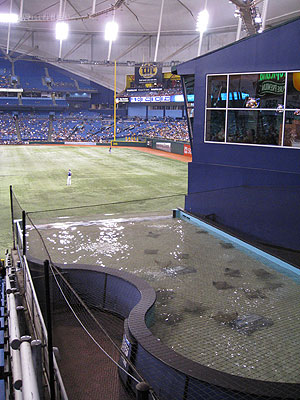 The home of the Rays has been the home to the rays since July 21, 2006. That's the day the Rays Touch Tank opened to the public.
The home of the Rays has been the home to the rays since July 21, 2006. That's the day the Rays Touch Tank opened to the public.
Made of fiberglass, the 35-foot long, 10,000 gallon tank was hoisted into place behind the right-center field wall by a pair of cranes on May 23, 2006. It can hold up to 30 cownose rays, named so because their blunt snout resembles a cow's nose. The real life team mascots are provided through a partnership with the Florida Aquarium, which staffs the site during games and monitors the rays at all other times. Caught in the waters of Tampa Bay, the cownose rays in the three foot deep tank have had their stinger removed, making the normally mild-mannered sea animals completely safe to touch. For $4 fans can purchase raw fish from aquarium staff to feed to the appreciative rays. Using their fins to produce suction, the rays quickly suck the food into their mouths directly from your hand. You can actually feel the suction and often the dental plates that the rays use to process their food. A hit with fans from the beginning, up to 50 people can fit into the tank area. To visit it, fans can pick up a card near the tank with a designated visitation time. Visits last close to 10 minutes. It should go without saying, but the ray touch tank is the only one of its kind at a professional sports venue. It's also one of the ten largest in the United States. And if by chance a Rays player hits a ball into the tank during a game the team donates $5,000 to charity, which is split evenly between the Florida Aquarium and the homering player’s charity of choice.
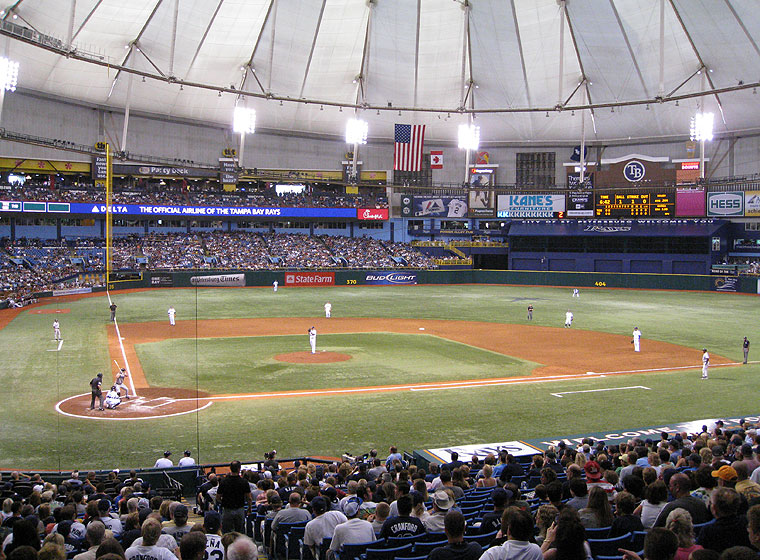
Tropicana Field Footnotes - Facts & Figures
| |||||||||||||||||||||||||||||||||||||||||||

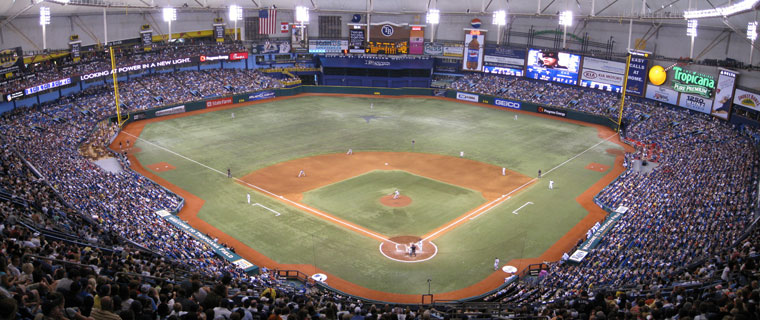
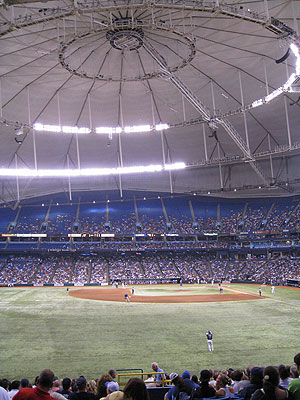 The roof itself was once the world's largest cable-supported domed roof. Only the Georgia Dome, completed in 1992, is larger today. Tropicana Field's roof is made of six acres of translucent, Teflon-coated fiberglass that virtually supports itself with 180 miles of cables connected by struts. Built to withstand hurricane force winds of up to 115 MPH, the roof uses opposing forces of tension and compression to maintain its arc.
The roof itself was once the world's largest cable-supported domed roof. Only the Georgia Dome, completed in 1992, is larger today. Tropicana Field's roof is made of six acres of translucent, Teflon-coated fiberglass that virtually supports itself with 180 miles of cables connected by struts. Built to withstand hurricane force winds of up to 115 MPH, the roof uses opposing forces of tension and compression to maintain its arc.
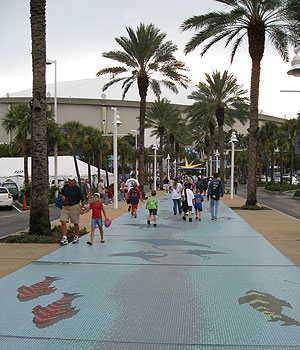 Decorative touches aren’t limited to the inside of the dome. Large baseball bats are attached to its exterior. A palm tree lined path that leads to the rotunda is tiled in a tropical theme, with different types of fish and sea creatures the highlight of the 900-foot ceramic mural walkway. Made with 1,849,091 tiles, all 1 x 1 inch in diameter, the walkway is the largest outdoor ceramic mural in Florida and one of the five largest in the United States.
Decorative touches aren’t limited to the inside of the dome. Large baseball bats are attached to its exterior. A palm tree lined path that leads to the rotunda is tiled in a tropical theme, with different types of fish and sea creatures the highlight of the 900-foot ceramic mural walkway. Made with 1,849,091 tiles, all 1 x 1 inch in diameter, the walkway is the largest outdoor ceramic mural in Florida and one of the five largest in the United States.


